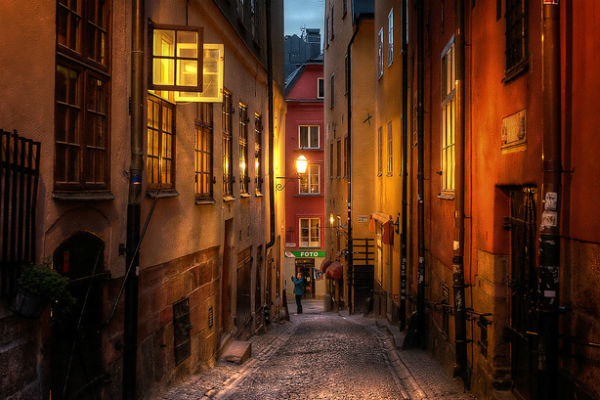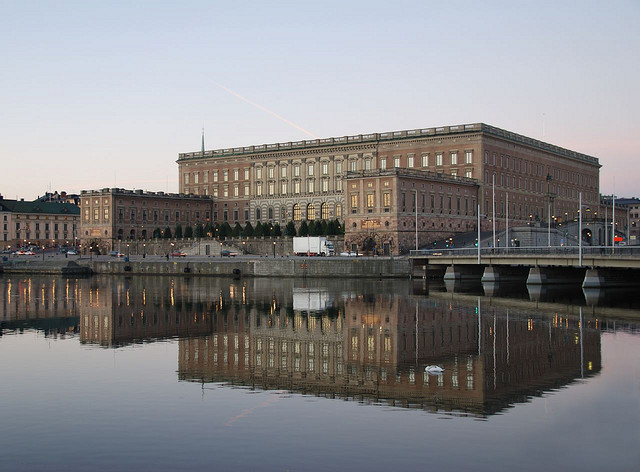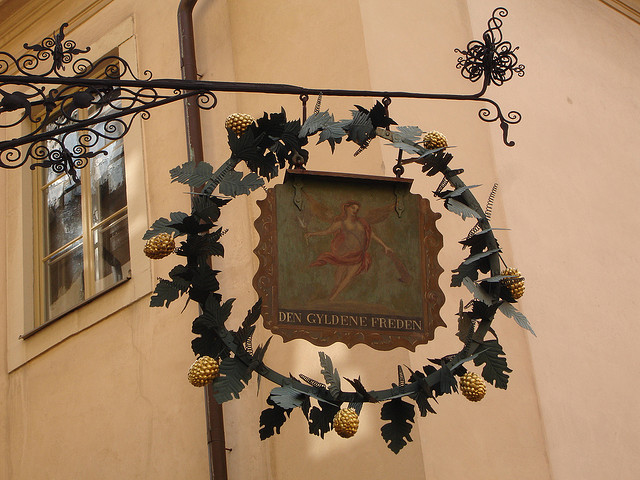Stockholm’s Gamla Stan, which translates to “Old Town,” is one of the largest and best-preserved medieval city centers in Europe, and summer is the perfect time to visit in order to take advantage of long days and late sunsets—with over 18 hours of light each day in which to explore.

A street in Gamla Stan, the old town of Stockholm. (Photo: Pedro Szekely via Flickr)
Made up of 14 islands surrounded by the rough waters of the Baltic Sea at the mouth of Lake Mälaren, Stockholm is often called the Venice of the North. Connected by beautiful bridges, colorful facades line waterways in almost every direction you look, and Gamla Stan is at the heart of it all, the growing city’s original center founded way back in 1252.
Easily accessible by walking across a short bridge or taking the metro to the Gamla Stan station, the Old Town is mostly car-free, a glorious labyrinth of cobble-stoned streets and alleys, ancient churches, cozy cafes, museums and plenty of shopping, from antiques to boutiques.
While it is possible to rush through it in a few hours, it’s more gratifying to spend at least a night or two in its splendor, or better yet base yourself here to explore the rest of Stockholm. There are plenty of modern boutique hotels to choose from, as well as the more adventuresome Mälardrottningen Hotel on a yacht or The Old Town Lodge, located deep in a 17th century vault where the old city walls are still visible.
Gamla Stan’s townhouses, merchant houses and meeting squares borrow from northern German architecture, but its warm, bright palette of mustard, rust and coral is all its own—making it truly unique. There is no better example of this amalgam than Stortorget, the oldest square in the city, located in the center of the Old Town. Best seen just before sunset when the golden light ricochets glowing colors around the square, shades of electric orange reflect off windows and strong beams of color shoot down narrow lanes at all angles.
Narrow indeed. While Köpmangatan is the oldest street documented in Stockholm, Mårten Trotzigs Gränd is the steepest—and the slenderest—tapering down to under three feet wide. Though not easy to locate, this precarious passageway can be found by those who search behind the Iron Square. Besides, getting lost can be the most rewarding way to discover the ancient architecture: cellar vaults and frescoes from the middle ages hide behind slightly more modern facades, gargoyles peek out around door frames beckoning visitors down alleys, and old iron casement windows, candle-lit, lure guests inside.
To see it now with its flowering potted plants, charming pubs and welcoming shops, it’s hard to believe Gamla Stan was considered the slum of Stockholm during the mid-19th to mid-20th centuries, many of its historic buildings left in disrepair. By the early eighties, however, preservation had begun and it has become not only a tourist attraction, but a highly sought after address—with only 3,000 lucky residents calling it home.
Browsing and Buying, from Books to Boutiques
Several thousands more commute in to cater to the approximately 10 million tourists who pass through each year, working in the many restaurants or specialty stores. In fact, Gamla Stan is especially alluring for those who like to shop, both for browsers and serious collectors. Popular with aficionados of handicrafts, curios and souvenirs, the Old Town has everything from jewelry to fashion, from antique toy stores to specialty book shops, from ceramics to quirky wooden trolls and elves of every shape and size. There are “dalahästen” for sale, the wooden hand-painted horses Sweden is famous for, as well as top-quality hand-knitted wool hats and sweaters, and plenty of elk-themed items, from coffee cups to oven mitts.
Upon entering the main street Västerånggaten, it’s best to walk past the most touristy and sometimes tacky souvenir shops to find the true gems, then hit the side streets and Osterlanggaten, where you will find more serious artisans selling crafts made of wood, glass and leather. Perusing the serene, tidy—and often tiny—shops with old wood beam ceilings and understated décor juxtaposed to contemporary design one can see firsthand the tasteful aesthetic Scandinavians are known for. Beyond the products, the ambient spaces themselves are a draw, making for a pleasant shopping experience.
Moving from the material world to the spiritual one, you won’t wander far without seeing Riddarholmskyrken’s massive black cast iron steeple shooting up like black lace, the highest point in Gamla Stan and an icon in photos of the Old Town. Unarguably one of Stockholm’s most beautiful churches, it’s the only remaining medieval abbey, and has been the royal burial church since the 16th century. Storkyrkan, The Swedish Cathedral, is another stunning sanctuary, originating as a 13th century Gothic structure until the exterior was remodeled in the baroque style around 1740. An equally impressive example of baroque architecture is the Tyska Kyrken, the first German-speaking parish outside of Germany, more proof of the importance of German merchants in Stockholm’s history.
For a more regal affair, visit the Royal Palace, dominating the northeastern part of the island. Built between 1697 and 1754, it is the official residence of the king of Sweden. However, unofficially, the royal family lives at Drottningholm, leaving it open to the public unless it’s being used for a state ceremony. You can tour the lavish royal apartments, the kroner museum, the treasury and the museum of antiquities.

Stockholm Royal Palace. (Photo: Anders Adermark)
The Nobel Museum is located in the old Stock Exchange House, an exquisite exhibition space in which you can learn all about the history of the prestigious Nobel Prize and hear videotaped speeches by the laureates. Tours in English run throughout the day and “talk-abouts,” short lectures, are given at 5:00 daily at the Bistro Nobel, where you can enjoy a glass of wine and a light bite while a historian speaks on different topics in a casual environment, offering up juicy tidbits and lesser known facts about all things Nobel.
Cute Cafes and Medieval Menus
When you’re ready to rest from so much visual and audio stimulation and to titillate your taste buds instead, choose from two sister cafes on the south side of Stortorget, the Kaffekoppen (coffee cup) and the Chokladkoppen (chocolate cup) next door, perfect spots to see the aforementioned sunset, although also lovely for breakfast, lunch or a sweet treat any time of day. Both are charming and cozy inside, if a bit cramped, but there is plenty of outdoor seating on nice days. Although popular, they’re unpretentious, old-fashioned cafes with an energetic vibe in well-preserved 17th century Nordic Renaissance style buildings.
Conquer a heartier appetite with the adventurous medieval cuisine at Aifur and experience the “gastronomical heritage from the Viking age.” Great for groups or couples, the restaurant is somewhat thematic in nature, but feels convincing down to the last detail, including cutlery that could double as weaponry! Walking down a narrow staircase lined with fiery torches, you are transported to the Middle Ages with long tables and benches covered in sheepskin, and ancient shields and tapestries lining the walls. The music and menu is Viking inspired, with hearty, tasty meals complete with explanations of each delicacy’s origin spelled out on the menu.

Den gyldene freden (The Golden Peace) is a restaurant in Gamla Stan, Stockholm dating back to the 18th century. (Photo: Eoghan OLionnain)
For a splurge, and to see an authentic 18th century tavern, dine at Den Gyldene Freden, listed in the Guinness Book of World Records as the oldest restaurant in the world to have the same interior and surroundings, more or less unchanged since the day the restaurant opened in 1722. Over the centuries it has been a hangout for many of Sweden’s famous writers, painters and songwriters, and even now on Thursdays the Swedish Academy meets here to nominate the candidates for the Nobel Prize for literature.
Stockholm is an ideal destination for a holiday, and gallivanting in Gamla Stan will only elevate the experience. From its rich history to its current forward-thinking culture, the Old Town will tantalize you with its fine restaurants, underground bars and wine cellars, shops and galleries. From the gold and copper glow of the buildings to the deep indigo blue of the night sky—which never goes completely dark in the summer season—Gamla Stan is colorful in every sense of the word.